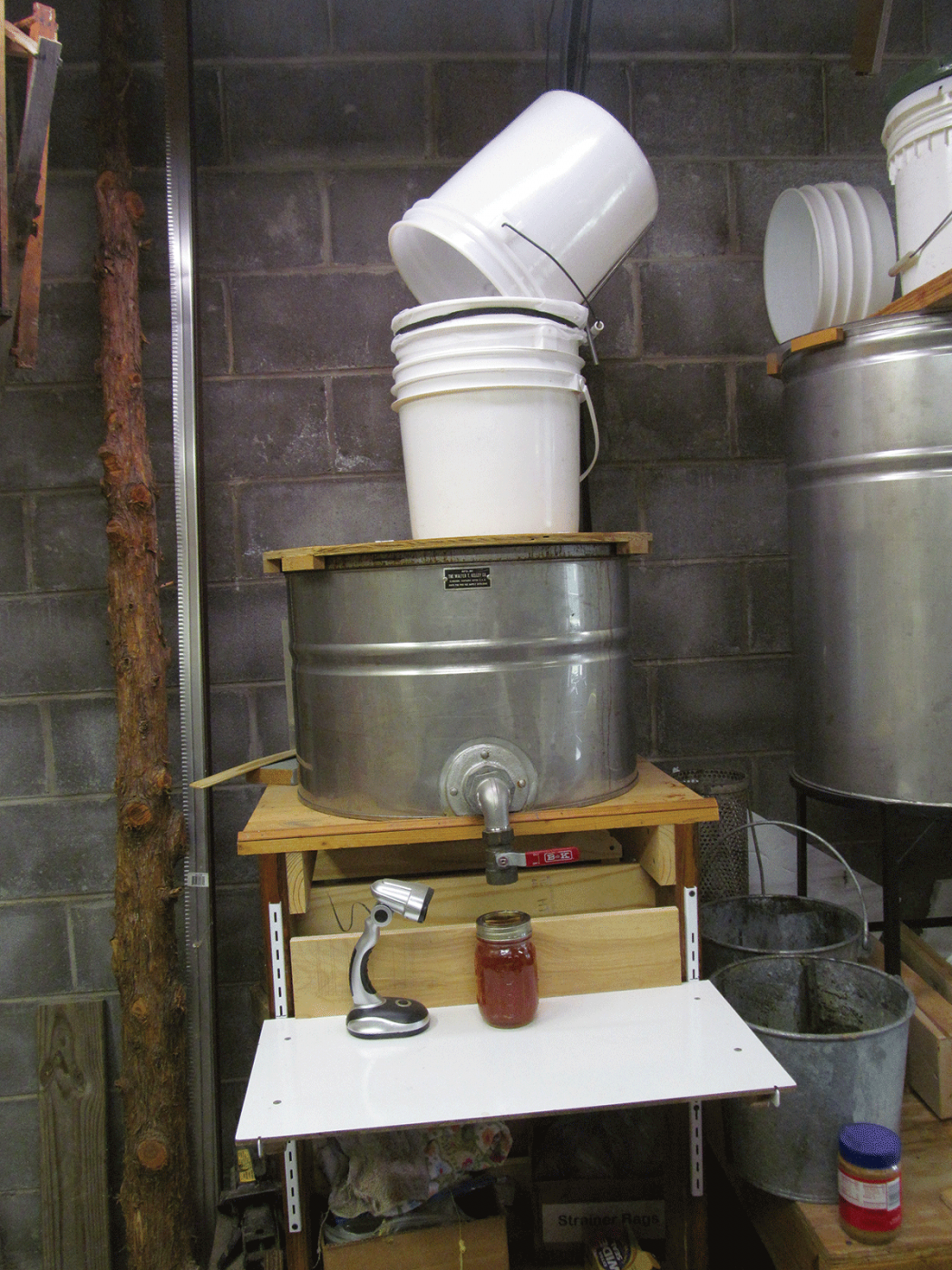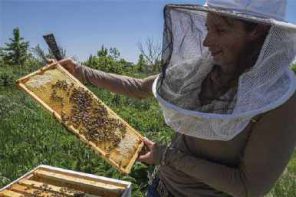By: Lonnie Funderburg
“There is no spigot on the side of the box.”
My wife and I have a system. I stand over next to the observation hive and talk about bees. She stands over next to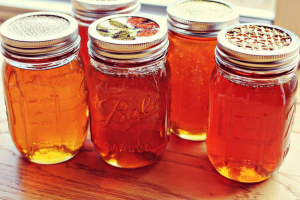 the honey, candles, soap, lip balm, skin cream, lotion bars, i.e. the stuff she makes and sells. She tells me, “You stand over there and talk about bees. I’ll sell the honey.” Our system must be working. We have been the resident honeybee exhibit at this arts and crafts festival for 25 years. I do what she tells me to. We’ve been married for forty-two years.
the honey, candles, soap, lip balm, skin cream, lotion bars, i.e. the stuff she makes and sells. She tells me, “You stand over there and talk about bees. I’ll sell the honey.” Our system must be working. We have been the resident honeybee exhibit at this arts and crafts festival for 25 years. I do what she tells me to. We’ve been married for forty-two years.
At this festival where I have been the beekeeper for 25 years, I am not exaggerating when I say that 6,000 people might walk by on a three-day weekend. One of the most common questions of all these people is, “How do you get the honey in the jar?” After carefully explaining the process in detail for too many years, in 1999, I finally made a picture board showing the significant steps in the procedure. It’s time to re-do the photos. My grandson is in one photo when he was just over two years old. He’s seventeen now. Anyway, this is how I get the honey into the jars.
When I began beekeeping, I had a partner. Together, we acquired a Kelley 33-frame extractor. No, we didn’t have the foggiest idea that a 33-frame extractor was much too large for our operation. The purchase included several beehives. Pay attention, I did not say colonies. Also included in the purchase was a Kelley bee blower. It was an all-or-nothing proposition. So, for several years, I used a Kelley bee blower to blow the bees out of their supers because I had a bee blower. Likely, it was only when the bee blower quit working that I began using a fume board. It was an epiphany. The operation became quiet. The bees are calm, not flying. Of course, the fume board does not get all the bees to leave the supers.
For a few more years, I pulled all my honey on one day, drove about 30 minutes to a friend’s house, and extracted until the wee hours of the night. In 1999, I bought my own extractor. Another epiphany! I began pulling only the number of supers that I felt like extracting. I no longer dreaded extracting day.
This is a purely personal recommendation. Do not allow your bees to put up surplus honey in a deep super. If you value your back, do not pick up a deep super of honey. If, for some legitimate reason, you do have a deep super of surplus honey, you are authorized and encouraged to remove the individual frames and place them in another deep super that is already on your hand trucks or wheelbarrow.
At home, my honey house is in my basement, I stack the supers near the door. At dusk, I open the door, and the bees fly home for the night. It works. There may not be a single honey bee left in the supers. With no bees in the supers, my wife is more likely to help me extract. Be cautious here, the small hive beetles will still be in the supers. So, I must extract right away, within a couple of days at most. A trick that I have learned is to stack the supers above a West Small Hive Beetle Trap with a flood light above the supers. The SHB will avoid the flood light, and the light keeps the honey warmer. As I work down through the stack of supers, the SHB continue to move down and into the small hive beetle trap. The SHB do not like light.
I uncap utilizing a hot knife over an uncapping tank. After twenty-five years, I think I am on my third hot knife; they don’t seem to last forever like a hivetool. I have used a cold knife. It worked. The hot knife requires slightly less effort. I suppose, if I had only a couple of supers, the cold knife would be adequate. Usually, I take a cappings scratcher to get the low places on a frame. I have one of those plastic rollers covered with little spikes. It works too. A friend showed me how to use the hot knife to get the low places. I do not have the finesse with a hot knife that he has developed during his much longer beekeeping career.
When I was just a beginner, my father and I were visiting an old family friend who had been an avid beekeeper. When he learned that I had begun keeping bees, he asked if I would like to have a Dadant uncapping tank. I did not know what an uncapping tank was or how to use it. It was shiny stainless steel; so, I said, “Yes!” He had constructed a plywood cover to protect the uncapping tank when not in use. I used the tank with the plywood cover as a rolling table for nine years until I acquired my own extractor. Only then did I realize what a prize he had given me. I used to let the cappings drain for several days, maybe a few weeks. With the SHB, I am much more careful to render my cappings after just a few days.
As mentioned above, my wife makes lots of stuff with beeswax. She wants my cappings wax, and she does not want any “old comb with slumgum” mixed in with her cappings wax. So, I am very careful to keep her cappings wax separated from any other wax. Remember, I do what she tells me.
Last Summer, my wife was anxious to get some of our backyard honey because her friends were asking for local honey. How close does it have to be to be local honey? If the store-bought honey is from Iowa or China, isn’t anything made in my state local! Anyway, I brought in eight supers from the backyard for her to extract while I left town on business. No, wait, that was when I went to Colorado for a hike. When I returned, she had extracted the eight supers and had three five-gallon buckets of honey sitting near the extractor. “I couldn’t move the buckets of honey,” she said. Well, why didn’t you put just two gallons in each of seven buckets? “I didn’t think of that,” was her well thought-out response. Just because it is a five-gallon bucket doesn’t mean you have to fill it. Honey is heavy. Use your head more and your back less.
As I said, if there are very few bees in the supers, my wife will help me extract if she is caught up with her candle molding. I have a Dadant twelve-frame motorized radial extractor. I doubt I will outgrow this extractor. My 12-frame easily extracts a load before I uncap another twelve frames. The temperature makes a difference. If the honey is warm, it really extracts much faster than if the honey is cool. To super heat the honey, I have been known to put the supers in my garage, where it gets really hot in the Summer. Really warm honey is 95°F. The honey does not need to be any warmer to extract easily.
When the honey flows out of my extractor, I strain the honey through a double stainless steel sieve. This works well for maybe two loads of the extractor which yields about five gallons of honey. Sometimes more, sometimes less. My bees don’t always pack my supers full. I have two of these double stainless steel sieves. If the sieve is doing what it is supposed to do, that is, strain out stuff, it gets clogged up. I moved the honey into five-gallon jugs with small openings for many years. Some beekeepers call these plastic 60s. I was more comfortable with my honey in a jug rather than a bucket which has the whole top open. Buckets are much easier to fill and empty than jugs. I still have the jugs. I prefer to use buckets. If you have a friend who works in a restaurant or you can cultivate an association with a restaurant owner, they will have five-gallon buckets available for the asking. A little honey will really facilitate the acquisition. If you don’t leave them out in the sun, five-gallon buckets will last a long time.
Too much heat is detrimental to honey. It would be best if you could bottle your honey at room temperature. However, I find that room temperature honey will not pass through my cloth strainer. Very carefully, I warm my honey to about 90° – 100°F in my hot box. Warm honey will pass through my cloth strainer almost like water. I purchase my cloth strainers in the paint section at Lowe’s. They are actually paint strainers made to fit in a five-gallon bucket. Perfect!
“What is a hot box?” you ask. About 15 years ago while talking to a much more experienced beekeeper, I asked, 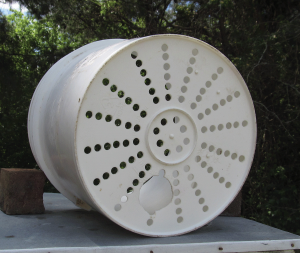 “How do you re-liquefy your honey when it granulates?” The short answer is that he gave me a defunct chest-type deep freezer. It may not be a freezer; but it is still an outstanding insulated chest. I bought a $20 space heater from Dollar General to warm the hot box. After tweaking the thermostat, the hot box will warm whatever I put in it to about 100°F. It takes about 48 hours in the hot box to re-liquefy a five-gallon bucket of honey that has granulated. I can fit eight five-gallon buckets in my hot box. Very carefully, I mean very carefully, I have warmed cold supers before extracting.
“How do you re-liquefy your honey when it granulates?” The short answer is that he gave me a defunct chest-type deep freezer. It may not be a freezer; but it is still an outstanding insulated chest. I bought a $20 space heater from Dollar General to warm the hot box. After tweaking the thermostat, the hot box will warm whatever I put in it to about 100°F. It takes about 48 hours in the hot box to re-liquefy a five-gallon bucket of honey that has granulated. I can fit eight five-gallon buckets in my hot box. Very carefully, I mean very carefully, I have warmed cold supers before extracting.
Back when I extracted with another beekeeper’s equipment, he would warm the honey in a 40-gallon tank with an agitator. Then we strained the honey through nylon cloth and allowed it to settle in another large tank for a few days. Before bottling, we would scrape off the foam on top of the honey. The foam is just air. I tasted it. The foam would dissolve in my mouth just like cotton candy. When I obtained my own extracting equipment, I began working on a means of eliminating the foam. It’s simple; do not let the honey splash. Minimize the distance the honey falls from the strainer to the bottom of the bottling tank. This is what I came up with.
My third and final strainer is the nylon paint strainer bag. This strainer bag is inside a five gallon bucket in which 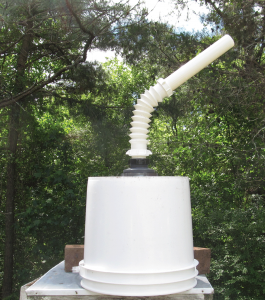 I have bored 3/8” holes in the bottom, about one hundred holes. There is only enough of the bucket bottom left to support the strainer bag. This bucket, with holes, is inside another five gallon bucket so that the bottoms of the two buckets are separated by only a couple of inches. In the center of the bottom of the second bucket, I cut a hole and added a sink strainer. The sink strainer serves to connect a section of 1½” flexible sink drain pipe to the bottom of the bucket. Connected to the flexible drain pipe is a straight 1½” drain pipe that is long enough to reach the bottom of my bottling tank. Along the straight section, I melted holes with a soldering pen so the honey could ooze out all along the pipe. This contraption is supported on top of my bottling tank with a circular piece of ½” plywood. With this arrangement, almost no air is infused into the honey as it enters the bottling tank. I try to let the honey rest in the bottling tank for a few days before bottling. The honey judges are satisfied with the clarity of my honey at this point as evidenced by a dozen or more ribbons from various honey contests.
I have bored 3/8” holes in the bottom, about one hundred holes. There is only enough of the bucket bottom left to support the strainer bag. This bucket, with holes, is inside another five gallon bucket so that the bottoms of the two buckets are separated by only a couple of inches. In the center of the bottom of the second bucket, I cut a hole and added a sink strainer. The sink strainer serves to connect a section of 1½” flexible sink drain pipe to the bottom of the bucket. Connected to the flexible drain pipe is a straight 1½” drain pipe that is long enough to reach the bottom of my bottling tank. Along the straight section, I melted holes with a soldering pen so the honey could ooze out all along the pipe. This contraption is supported on top of my bottling tank with a circular piece of ½” plywood. With this arrangement, almost no air is infused into the honey as it enters the bottling tank. I try to let the honey rest in the bottling tank for a few days before bottling. The honey judges are satisfied with the clarity of my honey at this point as evidenced by a dozen or more ribbons from various honey contests.
My bottling tank rests on a platform with the valve at the right height to observe the fill level. The only drawback 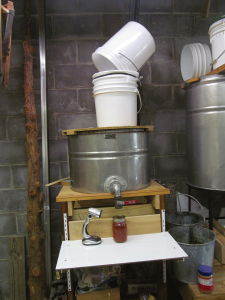 to this arrangement is pouring the honey into the strainer bucket that is on top of the bottling bucket. I refer you to previous instructions concerning filling a five gallon bucket with only two gallons of honey.
to this arrangement is pouring the honey into the strainer bucket that is on top of the bottling bucket. I refer you to previous instructions concerning filling a five gallon bucket with only two gallons of honey.
It has been too many years since I sold an unlabeled jar of honey. I do remember that my sales doubled when I had a label. Also, I can remember using paste to attach my labels. Now I use peel and stick labels. I feel the peel and stick labels are well worth the extra cost in saving time and eliminating the mess. The most recent label purchases were 10¢ to 17¢ each. After hearing from too many customers, “Your honey turned to sugar, so I threw it out,” I began using another label with instructions to re-liquefy the granulated honey, cost about 2¢. Recently, I began adding to my label “Product of USA”. Before you spend too much on labels, find out exactly what is required on your label in your state. Another thing, I get those shrink wrap sleeves. I believe the shrink wrap gives my customers another element of confidence in my product. My wife found the shrink wrap sleeves online for about 3¢ a piece. So, why do I spend upwards of 22¢ after the honey is in the jar? It is called marketing; it increases sales; it develops repeat customers; it gives me an extra element of satisfaction, all worth much more than 22¢.
Back to the picture board I mentioned earlier, after showing the photos and discussing the process with a potential customer, it is not uncommon for them to remark, “How do you sell it so cheap?”







